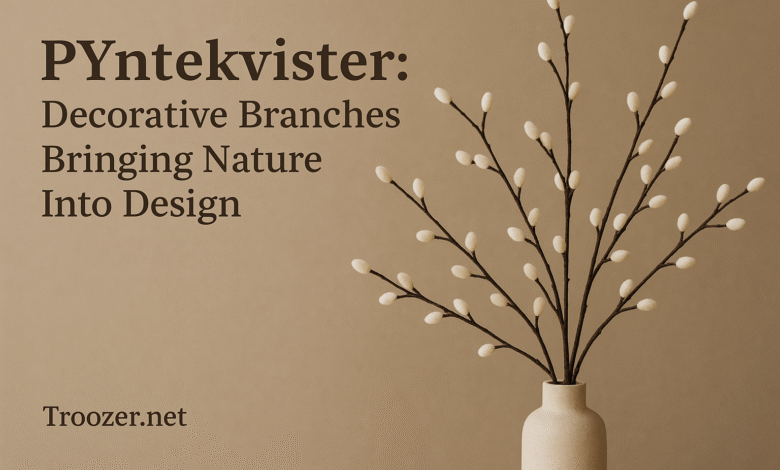Pyntekvister: Decorative Branches Bringing Nature Into Design

The world of interior decoration and event styling, the term pyntekvister has been gaining attention as a simple yet impactful way to enhance spaces. Originating from Scandinavian culture, the word “pyntekvister” translates to decorative branches, and it reflects the region’s deep appreciation for nature, minimalism, and beauty in simplicity. Over the years, pyntekvister have become more than just ornamental pieces; they represent a design philosophy that embraces natural textures, organic forms, and seasonal aesthetics.
This article explores the meaning, uses, and significance of pyntekvister in modern design, while also providing ideas for how they can be integrated into everyday life.
What Are Pyntekvister?
Pyntekvister refers to branches—real or artificial—that are used for decoration. These can be bare twigs, flowering stems, or leafy sprigs arranged in a vase, hung on walls, or combined with other décor elements. Unlike traditional bouquets that rely on colorful flowers, pyntekvister emphasize the understated charm of wood, bark, buds, and subtle foliage.
The beauty lies in their versatility. Pyntekvister can be rustic and raw, reflecting the outdoors, or styled with delicate ornaments for a more refined look. This adaptability makes them suitable for homes, offices, weddings, restaurants, and seasonal displays.
The Scandinavian Inspiration
Scandinavian culture is known for hygge—a sense of coziness and comfort—and lagom, which means balance or “just the right amount.” Pyntekvister perfectly capture these values. Instead of overwhelming a space with excess décor, a few well-placed branches bring warmth and elegance without clutter.
Pyntekvister are often used to mark seasonal changes. For example:
-
Spring: budding branches symbolize renewal and growth.
-
Summer: leafy stems add freshness and vibrancy.
-
Autumn: dry twigs and golden leaves reflect the earthy tones of harvest.
-
Winter: bare branches paired with candles or fairy lights create a festive, cozy feel.
This connection to nature helps people stay grounded, especially in modern urban settings where natural elements are often missing.
How to Use Pyntekvister in Home Décor
One of the reasons pyntekvister have become so popular is their accessibility. Unlike expensive furniture or elaborate decorations, branches can be sourced from gardens, parks, or craft stores. Here are some creative ways to use them:
1. Table Centerpieces
A simple vase filled with birch or willow branches can instantly elevate a dining table. For special occasions, adding small ornaments, ribbons, or seasonal flowers can make the arrangement more festive.
2. Wall Art
Branches can be mounted on walls as natural sculptures. Twigs arranged in geometric patterns or minimalist designs serve as artistic focal points, blending rustic charm with contemporary style.
3. Seasonal Displays
During Christmas, pyntekvister can replace or complement traditional trees. Decorated with ornaments and lights, they create a modern yet festive vibe. In autumn, branches with dried leaves can adorn entryways or mantels.
4. Eco-Friendly Décor
Unlike plastic decorations, pyntekvister are sustainable. Using fallen branches reduces waste while promoting eco-conscious living. For those preferring longevity, artificial versions provide the same aesthetic without requiring upkeep.
5. DIY Projects
Crafters often use pyntekvister for wreaths, mobiles, or hanging ornaments. Their natural texture adds authenticity and uniqueness to handmade designs.
Pyntekvister in Event Styling
Beyond homes, pyntekvister have become a staple in weddings, corporate events, and retail displays. Their elegance lies in their ability to create atmosphere without overpowering the theme.
-
Weddings: Couples often choose pyntekvister for rustic or bohemian ceremonies. Branches can be used in centerpieces, archways, or even as bridal accessories.
-
Corporate Spaces: Offices use pyntekvister to introduce biophilic design—bringing natural elements indoors to improve creativity and well-being.
-
Retail Displays: Shops incorporate them in window displays to highlight seasonal collections, especially during autumn and winter.
Their neutral tones make them easy to blend with different color schemes, ensuring they suit any occasion.
Symbolism of Pyntekvister
Decorative branches are not just visually appealing; they also carry symbolic meaning. Branches often represent growth, resilience, and connection to nature. Depending on the type of wood or plant, the symbolism may vary:
-
Willow branches: flexibility and adaptability.
-
Birch twigs: renewal and new beginnings.
-
Olive branches: peace and harmony.
This deeper meaning adds a layer of thoughtfulness to any space or celebration where pyntekvister are used.
Why Pyntekvister Appeal to Modern Lifestyles
In today’s fast-paced, technology-driven world, people are increasingly seeking ways to reconnect with nature. Pyntekvister offer an affordable and stylish method to achieve that. Their minimalism resonates with modern design trends, while their natural authenticity provides balance against synthetic surroundings.
As sustainability becomes a global priority, pyntekvister represent a move towards eco-friendly living. Choosing natural, reusable décor over mass-produced items supports both environmental responsibility and personal well-being.
Read More: Ceıvır: Exploring Its Meaning, Applications, and Digital Relevance
Conclusion
Pyntekvister may appear simple, but their impact on design and lifestyle is profound. From Scandinavian traditions to global décor trends, these decorative branches bridge the gap between nature and modern living. They embody elegance, sustainability, and symbolism—making them a timeless choice for homes, events, and creative projects.
Whether displayed in a vase, mounted as art, or used in festive celebrations, pyntekvister remind us of the beauty found in nature’s simplest forms. By incorporating them into daily life, we not only enhance our surroundings but also foster a deeper connection with the natural world.
